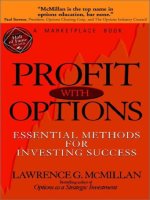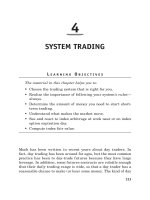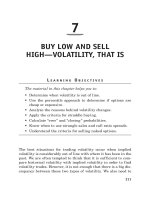Increasing alpha with options (2010)
Bạn đang xem bản rút gọn của tài liệu. Xem và tải ngay bản đầy đủ của tài liệu tại đây (3.33 MB, 223 trang )
INCREASING
ALPHA WITH
OPTIONS
INCREASING
ALPHA WITH
OPTIONS
Trading Strategies Using Technical
Analysis and Market Indicators
S COTT H. F ULLMAN , CMT
Copyright © 2010 by Scott H. Fullman. All rights reserved.
Increasing Alpha is a trademark of Fullman Technologies, Inc.
Published by John Wiley & Sons, Inc., Hoboken, New Jersey.
Published simultaneously in Canada.
No part of this publication may be reproduced, stored in a retrieval system, or transmitted in
any form or by any means, electronic, mechanical, photocopying, recording, scanning, or otherwise, except as permitted under Section 107 or 108 of the 1976 United States Copyright Act,
without either the prior written permission of the Publisher, or authorization through payment
of the appropriate per-copy fee to the Copyright Clearance Center, Inc., 222 Rosewood Drive,
Danvers, MA 01923, (978) 750-8400, fax (978) 646-8600, or on the Web at www.copyright
.com. Requests to the Publisher for permission should be addressed to the Permissions
Department, John Wiley & Sons, Inc., 111 River Street, Hoboken, NJ 07030, (201) 748-6011,
fax (201) 748-6008, or online at />Limit of Liability/Disclaimer of Warranty: While the publisher and author have used their best
efforts in preparing this book, they make no representations or warranties with respect to the
accuracy or completeness of the contents of this book and specifically disclaim any implied
warranties of merchantability or fitness for a particular purpose. No warranty may be created
or extended by sales representatives or written sales materials. The advice and strategies contained herein may not be suitable for your situation. You should consult with a professional
where appropriate. Neither the publisher nor author shall be liable for any loss of profit or
any other commercial damages, including but not limited to special, incidental, consequential,
or other damages.
For general information on our other products and services or for technical support, please
contact our Customer Care Department within the United States at (800) 762-2974, outside
the United States at (317) 572-3993 or fax (317) 572-4002.
Wiley also publishes its books in a variety of electronic formats. Some content that appears in
print may not be available in electronic books. For more information about Wiley products,
visit our web site at www.wiley.com.
ISBN 978-1-576-60365-9 (cloth); 978-0-470-87910-8 (ebk); 978-0-470-93673-3 (ebk);
978-0-470-93674-0 (ebk)
Printed in the United States of America
10 9 8 7 6 5 4 3 2 1
Technical analysis involves learning from history and experience in
order to project into the future. I therefore dedicate this book to the late
William H. Fullman, Jr., Sandie Fullman, James Boyd Taylor, and Doris
J. Taylor, who my wife and I have learned countless lessons from, and to
our children Jonathan William Fullman and Daniel Scott Fullman, who
we have taught and loved using those life experiences.
Contents
Acknowledgments
xi
Introduction
1
xiii
Why Technical Analysis?
1
Bases
Fundamentals vs. Technicals
Tops
2
The Basics of Technical Analysis
Understanding Chart Types
Trend Properties
The Trend Is Your Friend
Volatile or Negative Markets
Primary and Secondary Trends
First Strategy
Put Hedges
Implied Volatility
Seasonal Trends
Cyclical Trends
Moves within Moves
Nontrends
Understanding the Properties of Trends
3
Trends and Their Ends
3
6
8
13
13
16
18
20
20
22
24
24
25
25
27
28
29
33
Elliott Waves and Common Trend Analysis
Nesting Patterns
Continuation Patterns
vii
34
37
38
viii
Contents
Continuation or Reversal?
Opposing Reversal Patterns
4
Building Strategies around Reversal and
Continuation Patterns
Spotting Reversal and Continuation Patterns
Confirming Patterns Using Different Time Frames
Building Pattern-Based Strategies
More Complex Patterns: The Double Top
Continuation Patterns
An Amazon.Com Example
5
Oscillators
Oscillator Types
Stochastic Oscillator
Commodity Channel Index
Bollinger Bands
6
Oscillators and Strategies
Technical Indicators
Relative Performance
Finding the Strongest or Weakest Stocks
Money Flow and On-Balance Volume
7
Relative Performance
Look at the Board
8
ETF Strategies
Pairs
9
Efficient Pricing—Mostly
Exploiting Small Pricing Inefficiencies
10
The Subprime Mortgage Crisis and Options
Managing Delta
Delta Relationships of Stocks and Options
11
The Other Greeks
Other Products
Ex-Dividend Trades
Getting Information from the Exchange Floor
39
41
45
45
45
49
51
56
59
63
64
66
67
68
71
73
76
78
81
83
85
89
94
99
99
107
108
109
115
117
118
119
CONTENTS
12
When Conditions Change
Routine Changes
The Extremes
Meet the New Rules
13
14
The Changing Environment
129
Using Options to Protect Capital
137
Hedging the Broad Portfolio
When to Invest, When to Trade
Investors and Investment Markets
Trading an Investment Trend
The Trading Market
Japanese Candlesticks
Other Investment and Trading Opportunities
Upcoming Events
Mergers and Acquisitions
17
121
123
125
130
134
Reducing Hedge Costs
Pairing Up
Hedging Short Portfolios
Other Hedge Types
16
121
Controlling Risk, Fixing Problems
Using Global Markets
What Doesn’t Work
Single Security Hedges
Collar Hedges for Long Stock Positions
Other Hedges for Offsetting High Volatility Levels
Stock Replacement Therapy
15
ix
All About Resources
Abundance of Resources
Bloomberg Professional Service
MetaStock Professional Service
SuperCharts, Worden Brothers, and Others
Chart Books
Scanning Techniques
Options Resources
Other Helpful Resources from Bloomberg
iVolatility
137
138
142
144
148
157
161
164
165
168
171
171
172
177
182
184
185
187
189
189
189
192
193
193
193
198
198
198
x
Contents
Resources for Smaller Funds
Risk and Position Monitoring
Different Funds, Different Vendors
Other Information Sources
200
203
206
207
Appendix: Information Sources
209
Index
211
Acknowledgments
My wife, Deborah, her understanding with the time consuming writing
and editing deadlines.
Michael Ham, a colleague that has taught me much and who reviewed
my work and been there to bounce questions off of.
Ingrid Case, who edited the book and made insightful changes and
suggestions.
Steven Isaacs, project manager at Bloomberg Press, for all of his help
in producing this work.
The CEOs of WJB Capital Group, Craig Rothfeld and Michael
Romano, for their support in both writing this book and the work I do
for the firm and its clients each and every day.
Adam Futterman, head of derivatives trading, and the derivatives
trading team at WJB Capital Group for their insight on what clients are
looking for today.
John Roque and Adolfo Rueda, our technical team, for their insights
and inspiration.
My colleagues at WJB Capital for all of their efforts and conversations that led me to the decision to write this book.
John and Debbie Cirenza, Ray Dempsey, Michael Eisenberg, and
Carl Romick for their never ending input on the trading pits.
My friends and associates at the Market Technicians Association
(MTA), with whom I frequently consult in respect to the markets and
forms of analysis.
My many friends, colleagues, and associates at the options exchanges
and in the industry, whom I have learned a lot from and shared ideas with
over the years.
xi
Introduction
Welcome to the world of twenty-first–century investing, a world
of intertwined derivative products, analysis methods, and global markets in which countries’ politics, currencies, debt, and equities all
interact.
In this new world of investing, managers deal with a variety of dynamics, products, analyses, and risk controls. As ever, professional managers
concern themselves with resource availability and cost as they chase abovebenchmark performance and profits—called alpha—and compete against
other managers for new investment dollars. Many investment managers
focus on performance during most of their waking hours.
In doing so, they seek to balance risk against the possibility of
reward. Investment managers have always done this, of course, but the
job grew more complicated during the 1990s, when hedge funds and
mutual funds grew increasingly popular. The latter part of the decade,
particularly in the United States, was characterized by impressive market performance, the result of growth in technology and the Internet, as
well as financial service sector expansion. Hedge and mutual funds paid
top managers attractive compensation, which helped increase both the
number of funds and the competition among them.
Hedge and mutual funds examined every aspect of their businesses,
trying to maximize growth and performance. Many developed new techniques. Some of these resulted from new products, such as exchangetraded funds (ETF). Others came from new analysis applications, such
as pair trades that are derived from quantitative comparisons of two or
xiii
xiv
Introduction
more companies within the same group. Fund managers expanded the
ways they used arbitrage, short selling, and other traditional strategies.
More and more funds were managed from the United States and
Europe, though many were registered in other countries, allowing managers to attract more money from overseas and pay lower taxes.
The best-performing funds attracted more capital than their competition, boosting managers’ compensation even higher. Chasing ever-better
returns, some fund managers deviated from their normal practices and
directives, overleveraging and taking on extra risk. Sometimes that risk
was excessive or highly concentrated in a single market, sector, industry
group, or security.
Markets collapsed from the subprime mortgage crisis, which resulted
in a sharp sell-off and contraction in the credit markets. Most funds lost
money; those that were overleveraged and had taken on additional risk
often lost more than did their more conservative fellows. Some went out
of business, while others faced dwindling client bases.
Derivatives strategists—including me—learned a lot from this period.
Strategists saw that new strategies—and new uses of older strategies—
can help investors generate better profits at lower risk levels. In this
book, I will examine useful analytical techniques, showing readers how
to create alpha—profits—while also protecting positions from adverse
market changes.
The Prime Directive
Star Trek fans may remember the “prime directive,” the most important rule for anyone in Star Fleet Command. It stated, “No one shall
interfere in the governance and development of life on other planets.”
Starship captains and crews would sacrifice their own lives to obey the
prime directive.
In investment management, protecting capital and assets should
be the prime directive. People entrust managers with their money in
amounts that—whether they seem large or small to the manager—are
significant to asset owners, who worked hard to earn them. From competing choices, asset holders choose managers in whom they have some
confidence, basing their selections on factors that include track record,
education, references, and experience. Investment managers should
take clients’ trust very seriously, carefully considering their mandates
INTRODUCTION
xv
and investment positions—and the potential for quick changes in market
conditions.
Capital preservation is good for clients, but it’s also good for managers.
Strategies that preserve capital before pursuing profit may encourage
clients to keep money in a fund during a downturn and can offer better
profits in a rough market than can more risk-oriented tactics. Defensive
strategies and reduced losses may also attract capital away from competing
funds as investors review performance.
Why Technical Analysis?
Technical analysis, I believe, can help investment managers effectively
pursue the twin goals of capital preservation and profit.
Many people have asked me why I pursue technical analysis, rather
than fundamental analysis. In truth, I consider both. I look at the impact
of news— especially fundamental news— on a company or other financial instrument, particularly noting instances when a particular piece of
news does not have the expected effect. I look at unusual trading, looking
for the increased volume or price movements that can be a sign of new
accumulation or distribution. I also monitor the listed derivatives markets for unusual trading.
I focus on technical analysis, however, because profits and losses
happen on Wall Street—not at a company’s headquarters. I’m more
concerned with a stock ’s movements than with underlying company
fundamentals. What’s more, technical trends often change well
before fundamental shifts begin to show. This is especially true for
equities.
June 2007 offers an example of this phenomenon. The financial sector led a bull market that lasted from March 2003 to October 2007.
Financial company shares generally peaked in June. The stocks that
led the market higher, however, peaked nearly five months before the
major benchmarks set their cycle highs. Financial stocks’ downturn also
occurred as the companies continued to report growth, increased earnings,
and other good news.
Consider the case of Citigroup (NYSE: C). One of the largest and most
diverse financial services companies and banks in the world, Citibank
offers institutional and retail banking, investment services, investment
banking, and credit products from offices all over the world.
xvi
Introduction
Figure I.1 A weekly chart on Citigroup. Note how the stock broke the supporting trend
line in mid-July, the first warning signal that something was wrong.
Figure I.1 shows that Citigroup shares began to turn lower in July
2007, even as the company announced global operations expansion and
strong earnings. Technical analysis showed that the company had broken
a three-year supporting trend line, offering the first signal that something was wrong. A supporting trend line connects a trend ’s low points.
Several months later, the company began to report problems. The
first involved the declining value of residential mortgages, particularly
within Citigroup’s subprime loan portfolio. As borrowers defaulted on
those loans, Citigroup’s stock suffered. Ripple effects hurt the financial
services sector, and ultimately the entire world economy.
American casualties included Lehman Brothers (NYSE: LEH), Bear
Stearns (NYSE: BSC), and American International Group (NYSE: AIG).
Nearly all financial institutions felt the pain, as did businesses related to
real estate. Eventually, of course, the contagion spread to businesses and
economies around the globe.
Technical Analysis and Time Management
I have additional reasons, both practical and philosophical, for appreciating technical analysis. I am both a strategist and a Chartered Market
INTRODUCTION
xvii
Technician (CMT): a technical analyst who has passed a series of qualifying examinations from the Market Technicians Association (MTA).
I do a lot of customized programming, for clients as well as myself,
and create proprietary analytical tools that monitor global markets, sectors, industry groups, ETFs, individual stocks, commodities, currencies,
and other instruments. I focus on U.S. markets, but still search globally
for relationships that may signal Wall Street’s next move. My data may
not include every single market or instrument, but I’m still monitoring
an extremely large number of instruments. There are not enough hours
in the week to use fundamental analysis on each one.
Technical analysis, by contrast, makes it humanly possible to keep
track of all these instruments. In about an hour and a half each week
I get a general idea of which markets are performing well, which are
leading or laggards, and what general trends I might expect.
Next, I look at the major currencies and their interactions—particularly
when those interactions involve the U.S. dollar. The relationship between
the British pound and Japanese yen can also be very interesting, showing import and export trends and sometimes explaining other market
movements.
I move on to the commodities markets, which can sometimes shed
light on countrywide market movements—which in turn affect sectors,
industry groups, and individual stocks. At times, stocks or sectors in a
particular commodities market move before analysts see changes in the
market as a whole. Known as an instance of the tail wagging the dog,
this phenomenon can form the basis for profitable trades.
Then I consider sectors and industry groups, using different forms
of analysis to look at momentum, relative performance, money flow,
and other factors that can identify leaders, laggards, and trend changes.
I focus on currently important groups, identifying individual stocks
within those groups and trading those that are having the biggest
impact.
To focus on the U.S. markets—the world’s largest markets by country—
I spend about five hours reviewing technical charts for the best buy and
sell opportunities. In that time, I may identify continuing trends, stagnant formations, and trend changes. Once a week I look at daily charts
on nearly 3,000 issues; twice a month (or more, depending on market
activity) I look at weekly charts on the same issues; once a quarter I look
at monthly charts.
xviii
Introduction
I also consider individual stocks’ perceived risk, as measured using
options’ implied volatility readings and the implied volatility of relevant
market benchmarks. I often use the CBOE S&P 500 Implied Volatility
Index, also known as VIX, and sometimes referred to as the “fear gauge.”
The VIX measures implied volatility by reversing an options valuation formula, such as the Black-Scholes options pricing model, and using
an option’s current price to solve for the volatility level that the current
option value implies. When individual options have different risk premiums, traders can average or index implied risk figures to determine
the stock ’s implied risk. High risk typically goes hand in hand with high
options premiums, and thus with high implied volatility readings.
Options professionals typically sell higher premiums or volatility, a
strategy known as “selling gamma.” When premiums are low, professionals
purchase options, a strategy known as “ buying gamma.”
When risk perceptions are low, as they were in 2005 –2006, implied
volatility levels are generally low. Conversely, when risk perceptions are
high, as they were in 2008, implied volatility levels are generally high.
Figure I.2 is a weekly VIX chart showing changes in implied volatility
Figure I.2 A weekly chart on the CBOE S&P 500 Implied Volatility Index (VIX). Notice
the sharp increase in this indicator as the market adjusted risk valuations during the
late third-quarter and early fourth-quarter of 2008.
INTRODUCTION
xix
between 2005 and 2006, when implied volatility levels were generally
low, and in 2008, when risk perceptions were high. Note that the VIX
implied volatility dropped below 10 percent in 2006 (A), a historically
low reading. VIX rose to a historic high (B) of 89.53 percent, an indication that premiums were extremely high.
Because the VIX is an index based on S&P 500 stock options, its
reading may be lower than that of many of its component issues. An
index might move 10 percent in a single day, in extreme cases. On that
same day, one or more of the same index’s component issues may have
moved by more than 20 percent, and even above 50 percent. There is
a low probability that more than half the index’s components will reach
extreme thresholds, but there is a higher probability that more than half
the index’s components will exceed the index itself.
Strategies
I use all this information to create strategies. These are based not only
on price targets and anticipated movements, but also on market risk,
volatility, trading environment, and investors’ risk/reward profiles. In
many cases my published ideas may not meet clients’ risk/reward profiles,
so I look for other strategies that do meet their profiles.
Maximizing Profit, Minimizing Risk
Investment managers often worry about losing potential investors to
better-performing competitors. There are flexible ways to improve
performance without necessarily incurring more risk. The techniques
outlined in the chapters ahead will help reduce the frustration and confusion you might feel about those techniques, helping you take the best
advantage of all of the tools at your disposal.
INCREASING
ALPHA WITH
OPTIONS
Increasing Alpha with Options: Trading Strategies
Using Technical Analysis and Market Indicators
by Scott H. Fullman, CMT
Copyright © 2010 by Scott H. Fullman.
CHAPTER
1
Why Technical
Analysis?
If you’ve picked up this book, you’re probably at least interested in
technical analysis, but perhaps you’re not fully convinced that technical analysis should be part of your management plan. Maybe it’s not
your cup of coffee, or maybe it’s just not in your fund’s mandate. That’s
okay. Most funds have fundamentally based analysis and may be slow to
accept charting as a valid research tool, or options as valid investments.
But every time a strong bear market or significant correction appears—
accompanied by a volatility spike—more managers and funds begin to
at least consider options and chart patterns.
Stocks tend to move ahead of fundamentals; corporate information
and data can be as much as six months behind share movement. By
acting on information gained through technical analysis, managers can
sometimes prevent a fund from losing profits and/or capital. That’s a
compelling argument for technical analysis, even for fundamentalists.
Fundamental analysis considers companies in many different ways:
Outlook and business operations, balance sheet and income statement,
competitive factors, and other variables help analysts create fair market
valuations and price targets for underlying shares. Analysts closely monitor the effect of news and other events on a company, but they generally
form expectations for periods that exceed nine months and are sometimes as long as 18 months to two years. By the time fundamentals have
run their projected or extended courses, share prices may have peaked
or turned lower. (In many cases, investors see this as a buying opportunity, which may create a bounce.) Technical analysis can help you predict movements during those projection periods.
1
2
Increasing Alpha with Options
If you cannot or will not use technical analysis to make trading decisions,
you may at least want to use technical analysis to warn you of potential changes to fundamentals before they happen. Consider using and
monitoring monthly charts, and consulting the weekly charts if you see
a significant price change.
Consider some examples of how and why this works. Technical analysis works well in part because stock trading is tied to economic factors
and cycles, with sectors and industry groups moving higher and lower
based on their places in the cycle.
As cycles and economics play out, insiders buy and sell shares in
response to changing business expectations. Insiders— everyone from
the CEO to a guy on the loading dock—are often good at spotting the
factors that affect the company’s bottom line. Some of these individuals
may not be allowed to trade company stock; others (such as the guy
on the loading dock) may not be required to report trades to the
Securities and Exchange Commission (SEC), so their transactions
go unnoticed.
But officers and other qualified insiders can trade their own companies’ stock and must tell the SEC when they do. They notify the SEC —
and, through them, the rest of the financial world—through Form 4
filings. In Figure 1.1 we see that seven insiders sold 35,846 shares of
stock on June 8. The insiders bought many of those shares by exercising
corporate options days earlier.
SEC filings reveal insider trading. Share movements—in both price
and volume —show what the so-called smart money is doing. Smart
money, in this context, belongs to people who have a close company
association. They may be suppliers, customers, partners, service providers,
or others with knowledge and opportunities for close observance.
Share movement generally gets the attention of astute investors,
managers, and technicians. Price breakouts and other factors associated
with stock accumulation often attract new buyers and may bring the
first technical signal that the stock is breaking out. As more investors
and analysts begin to notice share movement, buying pressure will likely
increase, providing the breakout.
Low valuations are common when a stock is beginning to take off.
Real and estimated price/earnings ratios and price-to-book readings
will also be low, attracting value investors and managers. These leaders
usually help attract other buyers.
WHY TECHNICAL A NALYSIS?
3
Figure 1.1 This Bloomberg Professional news screen shows the sales of UNH shares
being filed with the SEC on June 8.
Most of the buyers that enter the market at this point are not looking
to make a quick profit. They are long-term investors who expect a target
company’s business to grow. They monitor business activity, looking
for improvements and checking whether or not their investments stay
on track.
Bases
After a company goes through a decline, shares typically go into a
low-volatility, sideways trend that’s called a base. Trend characteristics include contracting Bollinger Band lines and a low Average
Directional Momentum Index (ADX) reading. Share prices may be
relatively low compared to the past year or two. Look for basing on a
weekly chart rather than a daily chart, because a daily chart’s period
may not be long enough to show a real base, one that will support a
share breakout.
Bases don’t always happen, but they’re easy to identify and offer useful information, particularly when they last at least one quarter. That
happened for Apple Inc. (AAPL), shown in Figure 1.2. Note the stock ’s
sideways movement between October and March on the weekly chart,
4
Increasing Alpha with Options
Figure 1.2 This Bloomberg Professional chart of Apple Inc. (AAPL) shows the weekly
movement and the base that formed between October and March.
a pattern accompanied by waning volume. Measure upward from the
base along the x-axis to project a target stock price. The longer the base,
the greater the shares’ upward potential.
Figure 1.3 shows AAPL after the breakout. Our initial measurement
showed that the stock should move to around $150 from $101. The stock
hit that target nearly three months after the breakout for a gain of nearly
45 percent.
Volatility continued to contract as the base formed, declining on both
an implied (based on option premiums) and a historic (based on share
movement) basis. Figure 1.4 shows the continuous decline in volatility,
even after the stock broke out and rose from the base. (This is a daily
chart, not a weekly chart, so we are not showing an apples-to-apples
comparison between stock price and volatility.)
The low volatility level indicates that option premiums (and risk perceptions) were comparatively low, which provides an opportunity for
would-be investors. Because these investments are generally longer-term,
an investor can use the Long-tErm AnticiPation Securities (LEAPS™)
as an alternative to purchasing shares. LEAPS are long-term options,
initially listed for trading with about 30 months of life until expiration.
WHY TECHNICAL A NALYSIS?
5
Figure 1.3 Bloomberg Professional chart on Apple Inc. (AAPL) after the breakout. Note
how the stock was just below the $150 initial target price!
IVototility.com
100%
80%
60%
40%
Jul
Aug
Sep
Oct
30D HV
IV Index Mean
Nov
Dec
Jan
Feb
Mar
Apr
May
Jun
20%
Figure 1.4 30-day historic and implied volatility chart on Apple Inc. (AAPL), courtesy of
iVolatility.com.
Unlike regular options, these contracts are only on select stocks with
higher levels of trading activity, interest, and liquidity.
Advantages include the ability to leverage an investment by putting
up less initial capital. Risks include a potential total loss of capital—but
this is less than the cost of buying the shares in either a cash or margin
6
Increasing Alpha with Options
300
% Gain/Loss at Expiration
250
200
Option contract
150
100
50
0
Stock
–50
–100
166
160
154
148
142
136
130
124
118
112
106
100
94
88
82
76
70
–150
Stock Price at Expiration
Figure 1.5 Payoff chart for Apple Inc. comparing the stock vs. the purchase of the
long-term call option. Returns are based on intrinsic price at expiration. Time premium would likely add additional profit and percentage return prior to expiration.
account. Consider buying options that are equivalent to the stock you
might otherwise have purchased, then investing the remainder in a lowrisk instrument, such as a Treasury bond.
As shown in Figure 1.5, AAPL was at $106.85 as the breakout began.
A call option with a $110 strike price and nearly nine months until expiration cost $17. When the stock reached $146.40 on June 8, that option’s
price was $39.20. The unrealized gain was $22.20 per share, or 130.6
percent, compared to a potential gain of $39.55 per share, or 37 percent. Notice that the leveraged option return was nearly 3 1/2 times that
of the stock. These returns don’t include the approximate 2 percent gain
from owning Treasury securities.
Fundamentals vs. Technicals
For value investors, technical analysis may have helped confirm expectations that business conditions would improve. Insiders and those in
the know began to accumulate stock with the expectation that business
would improve later in the year.
WHY TECHNICAL A NALYSIS?
7
The base’s beginning shows that insiders bought 22,359 company
shares in two transactions. Several weeks later insiders sold small share
blocks, then bought another 33,296 shares in late January. After the
breakout insiders bought another 1,204 shares, and one insider sold
nearly 8,000 shares.
One might say that we missed the bottom by waiting for the
breakout— but we weren’t trying to fi nd the bottom. It’s impossible to
consistently find stock price bottoms, and doing so may mean tying up
capital in positions that resolve slowly. By giving up a small amount of
profit potential, we raise the probability of making a correct investment
decision.
As I noted earlier, basing patterns are usually most effective when
they take several months to form. Growth over one or two quarters provides a nice base and plenty of upside potential. The longer the base, the
greater the shares’ potential upward movement. However, investors who
own positions during the basing period commit capital and may sacrifice
other opportunities, especially if shares remain stagnant for an extended
period of time. A stock ’s sideways trend might last for more than a year,
giving market underperformance in a bull market and sometimes even
in a bear market. Such trends contribute little to fund performance or
investor loyalty.
Investors who buy long calls on a breakout see varying times to profitability. In some patterns a decline to the breakout point may follow
the breakout; the market tests that price point before the positive trend
resumes. This is a new buying opportunity for those that missed the breakout, or for those who bought partial positions. Once the positive trend
resumes, the pattern confirms that the breakout was not a false event.
Exit the position if the breakout point is violated and shares go back into
the sideways trend pattern or (worse) break the support.
A positive breakout affirmation should bring positive news from
the company—if not immediately, then in the near future. This should
increase trend momentum. A failed breakout suggests that fundamental
analysts should look for reasons that the stock is failing. If the stock continues to move lower on positive news, something is wrong.
Maintaining the long call position is important. Doing so lowers the
position’s risk and helps maintain market interest, and therefore liquidity.
Generally, however, investors take action on a stock position that moves
higher by at least 10 percent. In this situation a manager might sell
8
Increasing Alpha with Options
the long call and roll it into another long call in the same expiration
month, but at a higher strike price. The premium is less tied to the sold
contract’s economic value, so the move typically takes out most of the
initial capital and some profit, leaving a position with reduced capital
exposure.
A manager might also sell an out-of-the-money call option with a
closer expiration date, especially if the implied volatility level has risen
and the skew shows higher implied volatility on shorter-term than longerterm contracts. This would limit the potential upside, but the premium
received by writing these calls would increase profits if upward movement stalls, or if the stock goes into a corrective or consolidation phase.
Tops
Sideways patterns are also possible at tops, although they are less frequent and usually shorter. Implied volatility levels are usually relatively
low at tops, because investors may feel complacent following share
appreciation. Most investors are slow to sell a stock. They hope shares
will continue to rise, and they often feel loyalty toward the company
and its shares, especially after a significant gain. When the stock does
begin a descent, investors may think the decline is just a correction to
the advance and believe that the upward trend will likely resume in the
near future.
Tops often involve or anticipate real-time events: a slowdown in
orders, higher resource prices, contract loss, and competitive pressures.
A health care company, for instance, might face the loss of patent protection for a key product. Decreasing margins, stronger competition,
and lower profits will all put the company’s future under pressure.
Figure 1.6 is a daily chart on Johnson & Johnson from June 12, 2006
to January 26, 2007. The stock was at a high of $69.41 on October 23 and
then set a marginally lower high on November 7 at $69.03. An apparent
correction/consolidation pattern developed and lasted from mid-October
into mid-January, a three-month period.
Figure 1.7 shows that shares complete a short-term head-andshoulders top, but find support at the consolidation support line. The
stock breaks support on February 21, sending shares back toward
the June 2006 lows. Volume increases during the decline as momentum
increases.









